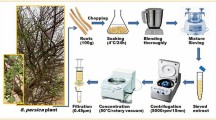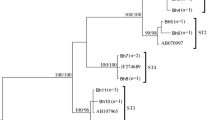Persistence activity manifested in the expression of anti-lysozyme, anti-lactoferrin, and antihistone factors promoting inactivation of natural anti-infection resistance factors in the body was revealed in Blastocystis hominis protozoa. Activities of these factors were ranged. The frequency of these factors in clinical isolates of blastocyst decreased in the following order: anti-lactoferrin activity (84.5±3.7%)→anti-lysozyme activity (64.8±5.7%)→anti-histone activity (48.1±2.3%). In healthy humans, the corresponding parameters were 7.3±1.3, 5.3±0.9, and 3.3±0.4%, respectively (p<0.05). It was shown that the studied activities in highly virulent blastocysts were higher than in groups of medium-, low-, and avirulent protozoa.
Similar content being viewed by others
References
Bukharin OV. Persistence of pathogenic bacteria: theory and practice. Zh. Mikrobiol. Epidemiol. Immunol. 2000;(4, Suppl.): 4-7. Russian.
Bukharin OV, Ginzburg AL, Romanov YuM, El’-Registan G I. Mechanisms of bacterial survival. Moscow, 2005. Russian.
Ilyina NA, Kasatkina NM. Intestinal parasitocenosis in gastroenterological patients. Sovremen. Naukoemkie Tekhnologii. 2008;(1):5. Russian.
Kozlov SS, Akhmedova MD, Zakhidova NA. Syndrome of endogenous intoxication in children with mixed intestinal parasitoses. Med. Parazitol. Parazitar. Bol. 2010;(1):17-19. Russian.
Nesterov AS, Potaturkina-Nesterova NI, Il’ina NA. Chronic dermatoses and blastocytic invasion. Ul’yanovsk, 2012. Russian.
Potaturkina-Nesterova NI, Krasnoperova YuYu, Isaeva IN, Il’ina NA. Characteristics of intestinal microbiocenosis in humans infested with blastocysts. Ross. Zh. Gastroenterol. Gepatol. Koloproktol. 2002;(5):215-216. Russian.
Potaturkina-Nesterova NI, Il’ina NA, Bugero NV, Krasnoperova YuYu, Nemova IS, Nesterov AS, Falova OE. Protozoa Blastocystis hominis and their influence on the host. Mezhd. Zh. Prikl. Fundamental. Issled. 2010;(11):94-95. Russian.
Sigidaev AS, Sukachev VS, Kurtukov MV, Zhdanov KV, Kozlov SS. Laboratory characteristics of blastocystis invasion in patients with chronic viral hepatitis. Zh. Infektol. 2011;3(4):62-66. Russian.
Tikhonova DV. The problem of blastocystosis in the world. Sechen. Vestn;(1):54-58. Russian.
Hameed DM, Hassanin OM, Zuel-Fakkar NM. Accociation of Blastocestis hominis genetic subtypes with urticaria. Parasitol Res. 2011;108(3):553-560.
Meloni D. Molecular subtyping of Blastocystis spp. Isolates from symptomatic patients in Italy. Parasitol. Res. 2011;109(3):613-619.
Vogelberg C, Stensvold CR, Monecke S, Ditzen A, Stopsack K, Heinrich-Gräfe U, Pöhlmann C. Blastocystis spp. subtype 2 detection during recurrence of gastrointestinal and urticarial symptoms. Parasitol. Int. 2010;59(3):469-471.
Author information
Authors and Affiliations
Corresponding author
Additional information
Translated from Byulleten’ Eksperimental’noi Biologii i Meditsiny, Vol. 161, No. 6, pp. 761-763, June, 2016
Rights and permissions
About this article
Cite this article
Potaturkina-Nesterova, N.I., Il’ina, N.A., Bugero, N.V. et al. Characteristics of Factors of Protozoa Blastocystis hominis Persistence. Bull Exp Biol Med 161, 804–805 (2016). https://doi.org/10.1007/s10517-016-3515-y
Received:
Published:
Issue Date:
DOI: https://doi.org/10.1007/s10517-016-3515-y




